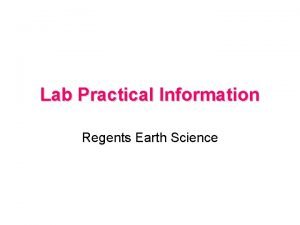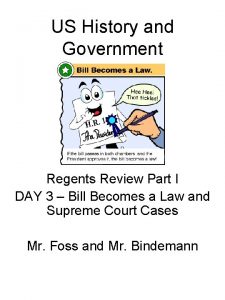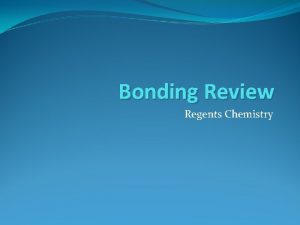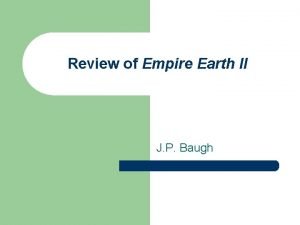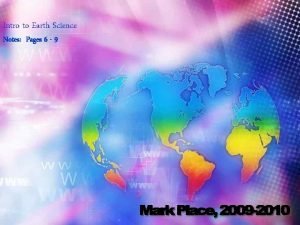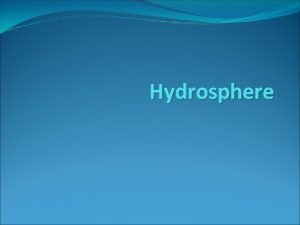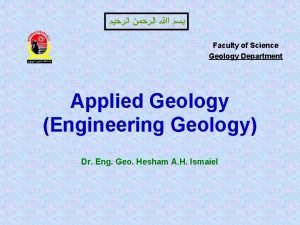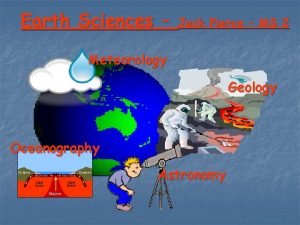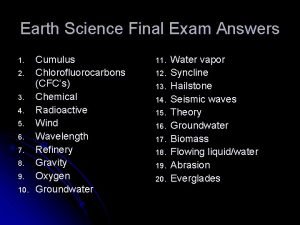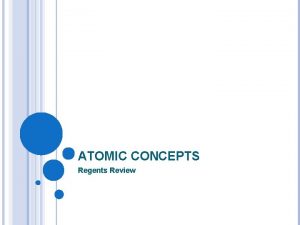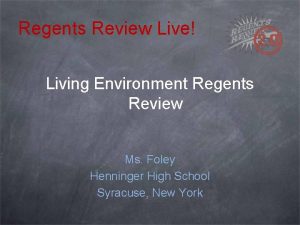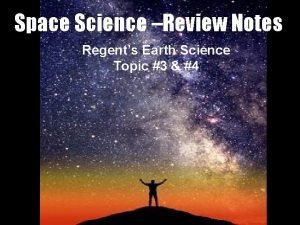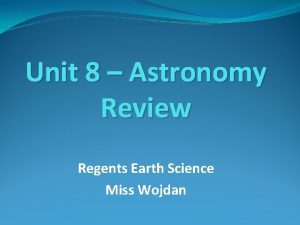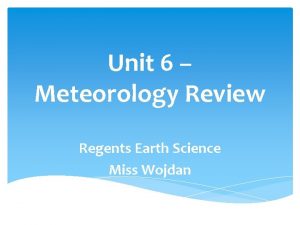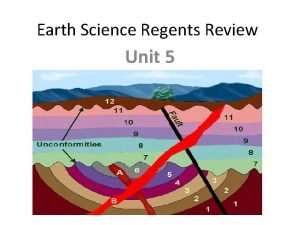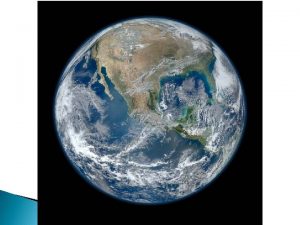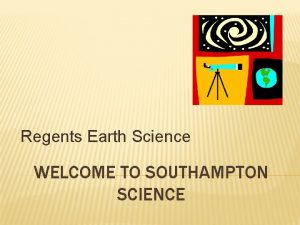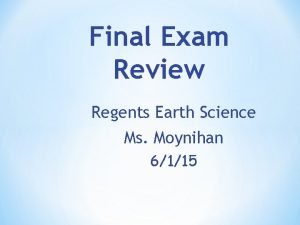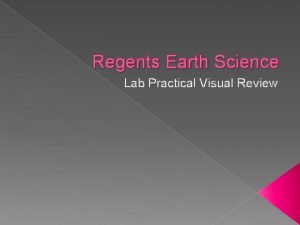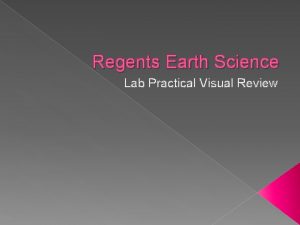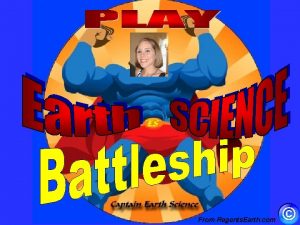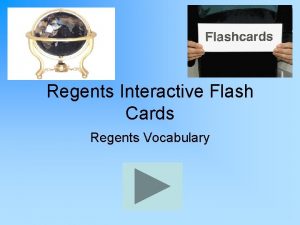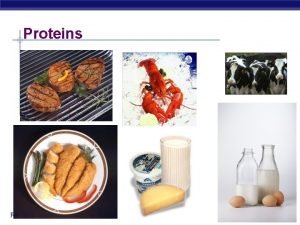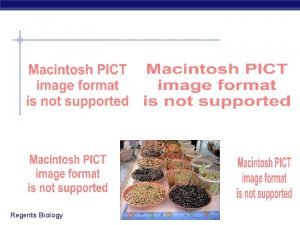Earth Science Regents Review Unit 2 1 What




























- Slides: 28

Earth Science Regents Review Unit 2

1) What are the five characteristics of a mineral? v Must be naturally occuring v Inorganic v Solid v Definite chemical composition v Definite crystal structure

2) What controls the physical properties of a mineral? v The internal arrangement of the atoms.

3) What are the five property tests for mineral identification? v A) color: least reliable; many minerals share the same color or a mineral may come in many colors.

v B) Luster: the way it shines; nonmetallic or metallic

v C) Streak: the color of the powder after rubbing on a streak plate (true color)

v D) Hardness: the resistance to being scratched.

v E) Cleavage or fracture: how it breaks (cleavage=sharp flat surfaces; fracture= jagged edges)

1) What is an igneous rock? ÜA rock formed from molten lava or magma.

3) Where can igneous rocks form? Ü (a) Deep inside the earth= intrusive Ü (b) At or close to the surface= extrusive

5) How can we tell how fast or slowly the igneous rock has cooled? Ü (a) Slow cooling= large crystals Ü (b) Fast cooling= small or no crystals

8) What is a vesicular texture and how does it form? Ü It is a texture with gas pockets that form when gases escape.

10) What are felsic rocks? Mafic? Ü Felsic rocks are light colored with low density. Ü Mafic rocks are dark colored with high density.

11) What features do igneous rocks have? Igneous rocks have intergrown crystals of different colors, glassy feature and vesicles.

1) What is a sedimentary rock? • Rocks that form from an accumulation of sediments.

3) Where do most sedimentary rocks form? • Large bodies of water.

4) What are the four methods of formation? • • Cementation Compaction Chemical action Biologic processes

5) What is the process of cementation? • Sediments lose water and the dissolved minerals in the pores precipitate out forming crystals.

8) How do chemical sedimentary rocks form? • Dissolved minerals drop out from water when it evaporates.

• 9) Are chemically formed sedimentary rocks monominerallic or polyminerallic?

13) What are the four features of a sedimentary rock? • • Layers Fossils Fragments stuck together Crystals all one color

2) How does metamorphism occur? ÜA rock is changed through intense heat or intense pressure or both.

4) What are some characteristics of rocks that have undergone recrystallization? Ü (a) Mineral alignment: minerals are squeezed and forced to line up Ü (b) Banding: alternating light and dark layers; “zebra stripes” Ü (c) Crystal grains that can’t be separated, i. e. sandstone into quartzite

5) What are the two types of metamorphism? Ü (a) Regional: intense pressure and some heat from mountain building Ü (b) Contact: intense heat from magma touching cold surrounding rocks

7) What are the two classifications of metamorphic rocks? Ü (a) Foliated: looks like layers in the rock caused by mineral alignment Ü (b) Nonfoliated: no layers but is a hard dense crystalline mass

8) Where are metamorphic rocks found? Ü Metamorphic rocks are found in between igneous and sedimentary rocks


9) What are the features of metamorphic rocks? Ü Banding (looks like zebra stripes) Ü Mineral alignment (looks like sparkly layers) Ü Hard, dense crystalline mass Ü Distorted structure (stretched out)
 Earth science regents lab practical review
Earth science regents lab practical review Earth science regents locating an epicenter
Earth science regents locating an epicenter Earth science lab practical
Earth science lab practical 282 ways to pass the earth science regents
282 ways to pass the earth science regents Unit 6 review questions
Unit 6 review questions Final exam study guide environmental science
Final exam study guide environmental science Earth science sol review
Earth science sol review Earth science review book
Earth science review book Earth science final exam
Earth science final exam Earth science prologue review
Earth science prologue review Us history regents review
Us history regents review American history regents review
American history regents review Regents chemistry bonding review sheet
Regents chemistry bonding review sheet My favorite subject
My favorite subject Forensic science unit
Forensic science unit Algebra 2 unit test
Algebra 2 unit test Empire earth ii review
Empire earth ii review Where do polar and tropical air masses develop
Where do polar and tropical air masses develop Earth science sol 2010
Earth science sol 2010 Earth science grade 9
Earth science grade 9 Dynamic equilibrium earth science
Dynamic equilibrium earth science Short note on hydrosphere
Short note on hydrosphere Science jeopardy 8th grade
Science jeopardy 8th grade Geology earth science definition
Geology earth science definition Earth science meaning
Earth science meaning Geology earth science definition
Geology earth science definition Zone of aeration
Zone of aeration Earth science lab practical
Earth science lab practical Earth science semester 2 final exam answers
Earth science semester 2 final exam answers


